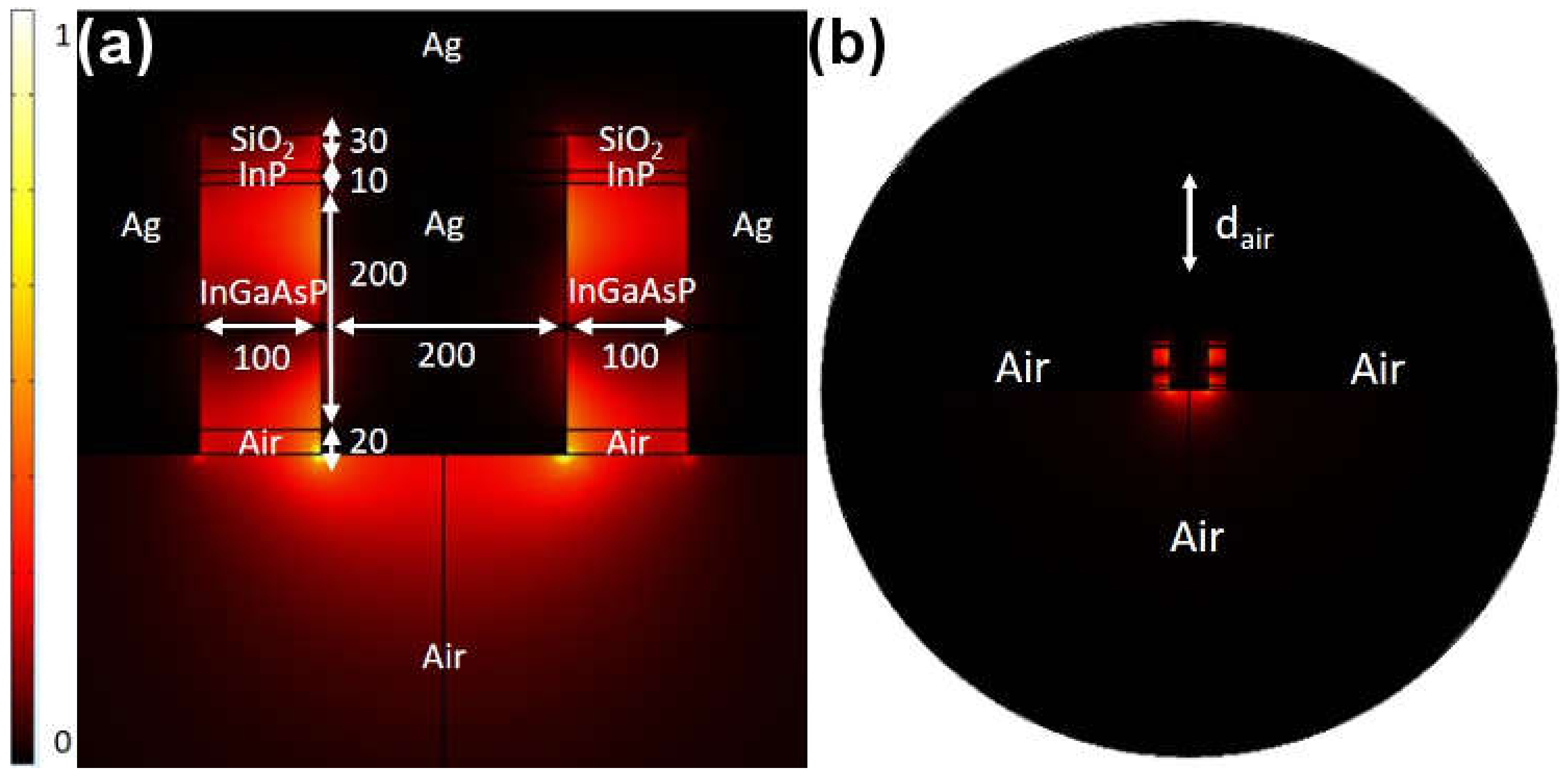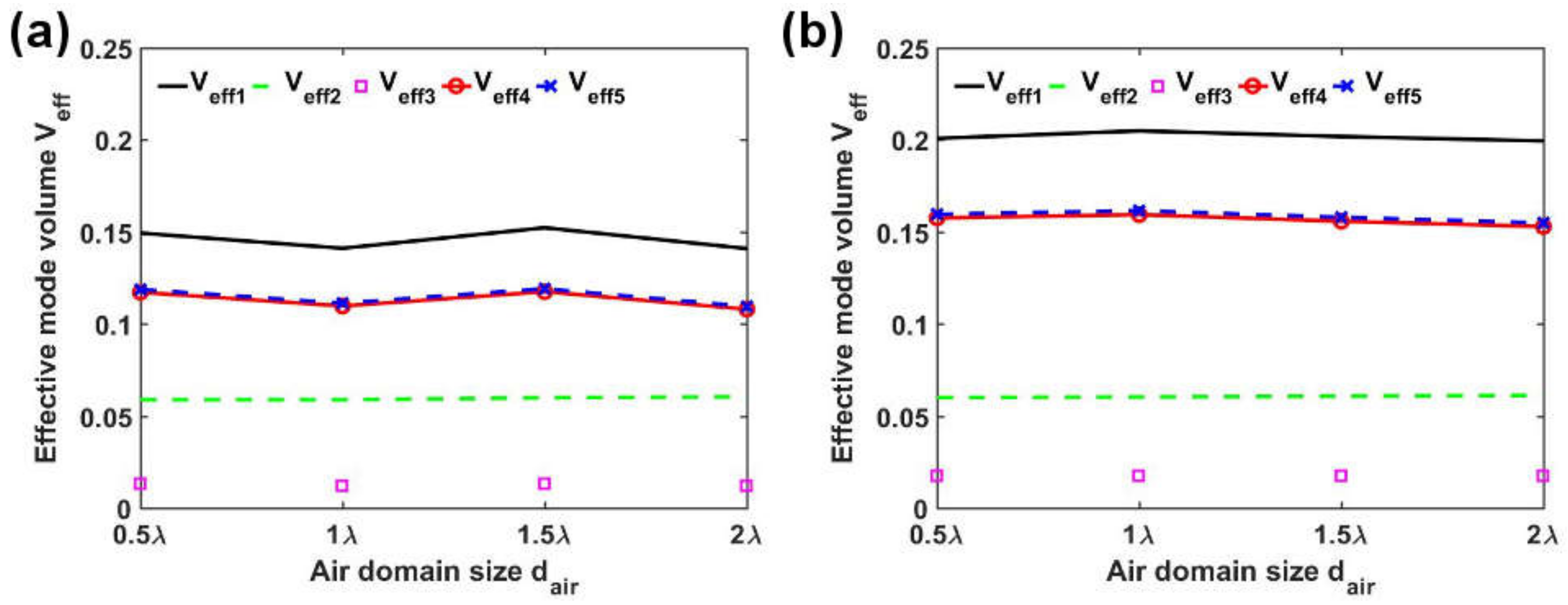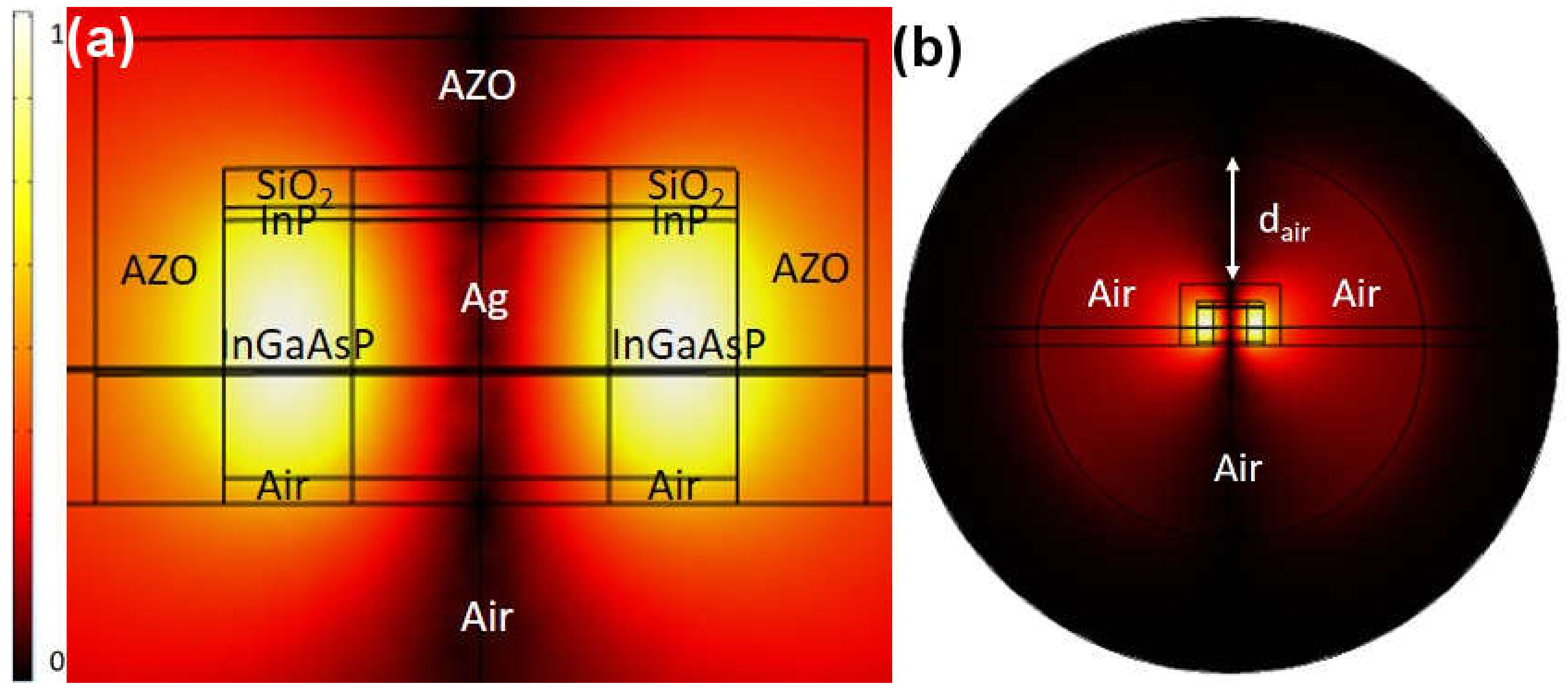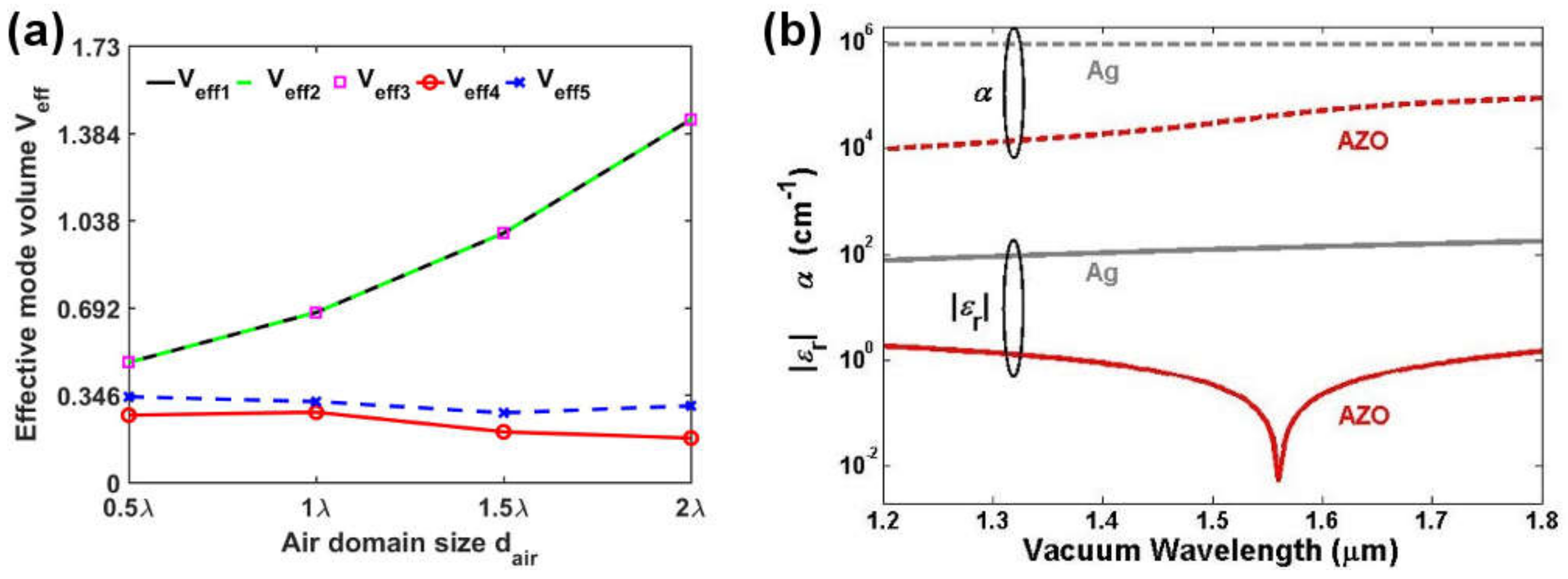Effective Modal Volume in Nanoscale Photonic and Plasmonic Near-Infrared Resonant Cavities
Abstract
Featured Application
Abstract
1. Introduction
2. Materials and Methods
3. Results
3.1. Metallo-Dielectric Resonator
3.2. Coaxial Resonator with Ag
3.3. Coaxial Resonator with AZO
4. Discussion
5. Conclusions
Author Contributions
Funding
Conflicts of Interest
References
- Miller, D.A.B. Device requirements for optical interconnects to silicon chips. Proc. IEEE 2009, 97, 1166–1185. [Google Scholar] [CrossRef]
- Gu, Q.; Smalley, J.S.T.; Nezhad, M.P.; Simic, A.; Lee, J.H.; Katz, M.; Bondarenko, O.; Slutsky, B.; Mizrahi, A.; Lomakin, V.; et al. Subwavelength semiconductor lasers for dense chip-scale integration. Adv. Opt. Photonics 2014, 6, 1. [Google Scholar] [CrossRef]
- Purcell, E.M. Spontaneous Emission Probabilities at Radio Frquencies. Phys. Rev. 1946, 69, 674. [Google Scholar] [CrossRef]
- Li, X.; Gu, Q. Ultrafast shifted-core coaxial nano-emitter. Opt. Express 2018, 26, 15177–15185. [Google Scholar] [CrossRef] [PubMed]
- Lau, E.K.; Lakhani, A.; Tucker, R.S.; Wu, M.C. Enhanced modulation bandwidth of nanocavity light emitting devices. Opt. Express 2009, 17, 7790. [Google Scholar] [CrossRef] [PubMed]
- Khajavikhan, M.; Simic, A.; Katz, M.; Lee, J.H.; Slutsky, B.; Mizrahi, A.; Lomakin, V.; Fainman, Y. Thresholdless nanoscale coaxial lasers. Nature 2012, 482, 204–207. [Google Scholar] [CrossRef] [PubMed]
- Vahala, K.J. Optical microcavities. Nature 2003, 424, 839–846. [Google Scholar] [CrossRef] [PubMed]
- Chang, S.W.; Chuang, S.L. Fundamental formulation for plasmonic nanolasers. IEEE J. Quantum Electron. 2009, 45, 1014–1023. [Google Scholar] [CrossRef]
- Smalley, J.S.T.; Vallini, F.; Gu, Q.; Fainman, Y. Amplification and Lasing of Plasmonic Modes. Proc. IEEE 2016, 104, 2323–2337. [Google Scholar] [CrossRef]
- Balanis, C.A. Advanced Engineering Electromagnetics, 2nd ed.; John Wiley & Sons Comp.: Hoboken, NJ, USA, 2012; ISBN 9780874216561. [Google Scholar]
- Snyder, A.W. Optical Waveguide Theory; Springer Science & Business Media: Berlin, Germany, 1983; ISBN 0412099500. [Google Scholar]
- Chang, S.W.; Chuang, S.L. Normal modes for plasmonic nanolasers with dispersive and inhomogeneous media. Opt. Lett. 2009, 34, 91–93. [Google Scholar] [CrossRef] [PubMed]
- Johnson, P.B.; Christy, R.W. Optical constants of the noble metals. Phys. Rev. B 1972, 6, 4370–4379. [Google Scholar] [CrossRef]
- Novotny, L.; Hecht, B. Principles of Nano-Optics; Cambridge University Press: Cambridge, UK, 2009; Volume 9781107005, ISBN 9780511794193. [Google Scholar]
- Oulton, R.F.; Bartal, G.; Pile, D.F.P.; Zhang, X. Confinement and propagation characteristics of subwavelength plasmonic modes. New J. Phys. 2008, 10, 105018. [Google Scholar] [CrossRef]
- Zhang, Q.; Li, G.; Liu, X.; Qian, F.; Li, Y.; Sum, T.C.; Lieber, C.M.; Xiong, Q. A room temperature low-threshold ultraviolet plasmonic nanolaser. Nat. Commun. 2014, 5, 4953. [Google Scholar] [CrossRef] [PubMed]
- Gao, J.; McMillan, J.F.; Wu, M.C.; Zheng, J.; Assefa, S.; Wong, C.W. Demonstration of an air-slot mode-gap confined photonic crystal slab nanocavity with ultrasmall mode volumes. Appl. Phys. Lett. 2010, 96, 051123. [Google Scholar] [CrossRef]
- Bahari, B.; Tellez-Limon, R.; Kante, B. Directive and enhanced spontaneous emission using shifted cubes nanoantenna. J. Appl. Phys. 2016, 120, 093106. [Google Scholar] [CrossRef]
- Gérard, J.M.; Gayral, B. Strong Purcell effect for InAs quantum boxes in three-dimensional solid-state microcavities. J. Lightware Technol. 1999, 17, 2089–2095. [Google Scholar] [CrossRef]
- Kristensen, P.T.; Van Vlack, C.; Hughes, S. Generalized effective mode volume for leaky optical cavities. Opt. Lett. 2012, 37, 1649. [Google Scholar] [CrossRef] [PubMed]
- Sauvan, C.; Hugonin, J.P.; Maksymov, I.S.; Lalanne, P. Theory of the spontaneous optical emission of nanosize photonic and plasmon resonators. Phys. Rev. Lett. 2013, 110. [Google Scholar] [CrossRef] [PubMed]
- Nezhad, M.P.; Simic, A.; Bondarenko, O.; Slutsky, B.; Mizrahi, A.; Feng, L.; Lomakin, V.; Fainman, Y. Room-temperature subwavelength metallo-dielectric lasers. Nat. Photonics 2010, 4, 395–399. [Google Scholar] [CrossRef]
- Riley, C.T.; Smalley, J.S.T.; Post, K.W.; Basov, D.N.; Fainman, Y.; Wang, D.; Liu, Z.; Sirbuly, D.J. High-Quality, Ultraconformal Aluminum-Doped Zinc Oxide Nanoplasmonic and Hyperbolic Metamaterials. Small 2016, 12, 892–901. [Google Scholar] [CrossRef] [PubMed]
- Hao, F.; Nordlander, P. Efficient dielectric function for FDTD simulation of the optical properties of silver and gold nanoparticles. Chem. Phys. Lett. 2007, 446, 115–118. [Google Scholar] [CrossRef]
- Smalley, J.S.T.; Gu, Q.; Fainman, Y. Temperature dependence of the spontaneous emission factor in subwavelength semiconductor lasers. IEEE J. Quantum Electron. 2014, 50, 175–185. [Google Scholar] [CrossRef]
- Joannopoulos, J.J.D.; Johnson, S.; Winn, J.N.J.; Meade, R.R.D. Photonic Crystals: Molding the Flow of Light; Princeton University Press: Princeton, NJ, USA, 2008; ISBN 9780691124568. [Google Scholar]
- Smalley, J.S.T.; Vallini, F.; Kanté, B.; Fainman, Y. Modal amplification in active waveguides with hyperbolic dispersion at telecommunication frequencies. Opt. Express 2014, 22, 21088–21105. [Google Scholar] [CrossRef] [PubMed]
- Kristensen, P.T.; Hughes, S. Modes and Mode Volumes of Leaky Optical Cavities and Plasmonic Nanoresonators. ACS Photonics 2014, 1, 2–10. [Google Scholar] [CrossRef]
- De Ceglia, D.; Vincenti, M.A.; Grande, M.; Bianco, G.V.; Bruno, G.; D’orazio, A.; Scalora, M.; Ceglia, D. Tuning infrared guided-mode resonances with graphene. J. Opt. Soc. Am. B 2016, 33, 426. [Google Scholar] [CrossRef]
- Lalanne, P.; Yan, W.; Vynck, K.; Sauvan, C.; Hugonin, J.P. Light Interaction with Photonic and Plasmonic Resonances. Laser Photonics Rev. 2018, 12, 1700113. [Google Scholar] [CrossRef]
- Filter, R.; Słowik, K.; Straubel, J.; Lederer, F.; Rockstuhl, C. Nanoantennas for ultrabright single photon sources. Opt. Lett. 2014, 39, 1246. [Google Scholar] [CrossRef] [PubMed]
- Kelkar, H.; Wang, D.; Martín-Cano, D.; Hoffmann, B.; Christiansen, S.; Götzinger, S.; Sandoghdar, V. Sensing nanoparticles with a cantilever-based scannable optical cavity of low finesse and sub- λ3 volume. Phys. Rev. Appl. 2015, 4. [Google Scholar] [CrossRef]
- Choi, H.; Heuck, M.; Englund, D. Self-Similar Nanocavity Design with Ultrasmall Mode Volume for Single-Photon Nonlinearities. Phys. Rev. Lett. 2017, 118. [Google Scholar] [CrossRef] [PubMed]
- Oskooi, A.F.; Kottke, C.; Johnson, S.G. Accurate finite-difference time-domain simulation of anisotropic media by subpixel smoothing. Opt. Lett. 2009, 34, 2778. [Google Scholar] [CrossRef] [PubMed]





| Metallo–Dielectric Cavity with Ag | Metallic Coaxial Cavity with AZO | Metallic Coaxial Cavity with Ag | |
|---|---|---|---|
| Photonic Mode | x | x | |
| Plasmonic Mode | x | ||
| Confined Mode | x | x | |
| Leaky Mode | x |
| Fine | Normal | ||
|---|---|---|---|
| PML | Type | Sweep | Sweep |
| Number of layers | 10 | 5 | |
| Cavity | Type | Free tetrahedral (extremely fine) | Free tetrahedral (fine) |
| Maximum element size (nm) | λL/(6·nInGaAsP) | λL/(4·nInGaAsP) | |
| Backgound | Type | Free tetrahedral (normal) | Free tetrahedral (normal) |
| Maximum element size (nm) | λL/(6·nair) | λL/(4·nair) | |
| Metal-dielectric boundary | Type | Free tetrahedral (extremely fine) | Free tetrahedral (extra fine) |
| Maximum element size (nm) | 10 | 20 | |
| Maximum Percentage Difference (%) | Cavity Types | |||
|---|---|---|---|---|
| Effective modal volume expressions | Metallo-dielectric | Coaxial-Ag (normal/fine) | Coaxial-AZO | |
| Veff,1 | 0.21 | 2.74 | 8.03 | 202.32 |
| Veff,2 | 0.21 | 2.02 | 2.90 | 202.32 |
| Veff,3 | 0.21 | 2.74 | 8.03 | 202.32 |
| Veff,4 | 0.18 | 4.24 | 8.79 | 57.98 |
| Veff,5 | 0.18 | 4.30 | 8.86 | 22.99 |
© 2018 by the authors. Licensee MDPI, Basel, Switzerland. This article is an open access article distributed under the terms and conditions of the Creative Commons Attribution (CC BY) license (http://creativecommons.org/licenses/by/4.0/).
Share and Cite
Li, X.; Smalley, J.S.T.; Li, Z.; Gu, Q. Effective Modal Volume in Nanoscale Photonic and Plasmonic Near-Infrared Resonant Cavities. Appl. Sci. 2018, 8, 1464. https://doi.org/10.3390/app8091464
Li X, Smalley JST, Li Z, Gu Q. Effective Modal Volume in Nanoscale Photonic and Plasmonic Near-Infrared Resonant Cavities. Applied Sciences. 2018; 8(9):1464. https://doi.org/10.3390/app8091464
Chicago/Turabian StyleLi, Xi, Joseph S. T. Smalley, Zhitong Li, and Qing Gu. 2018. "Effective Modal Volume in Nanoscale Photonic and Plasmonic Near-Infrared Resonant Cavities" Applied Sciences 8, no. 9: 1464. https://doi.org/10.3390/app8091464
APA StyleLi, X., Smalley, J. S. T., Li, Z., & Gu, Q. (2018). Effective Modal Volume in Nanoscale Photonic and Plasmonic Near-Infrared Resonant Cavities. Applied Sciences, 8(9), 1464. https://doi.org/10.3390/app8091464





